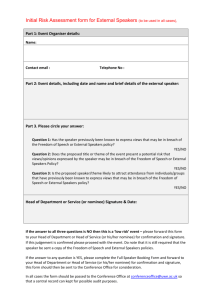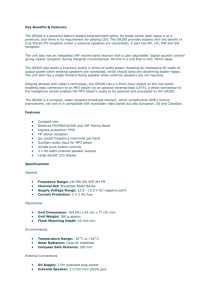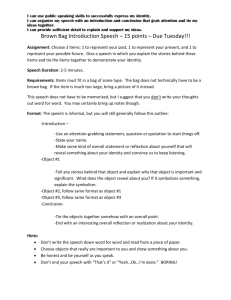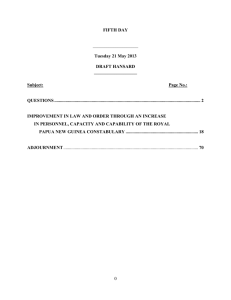SYN Public Speaking and Confidence Building Games
advertisement
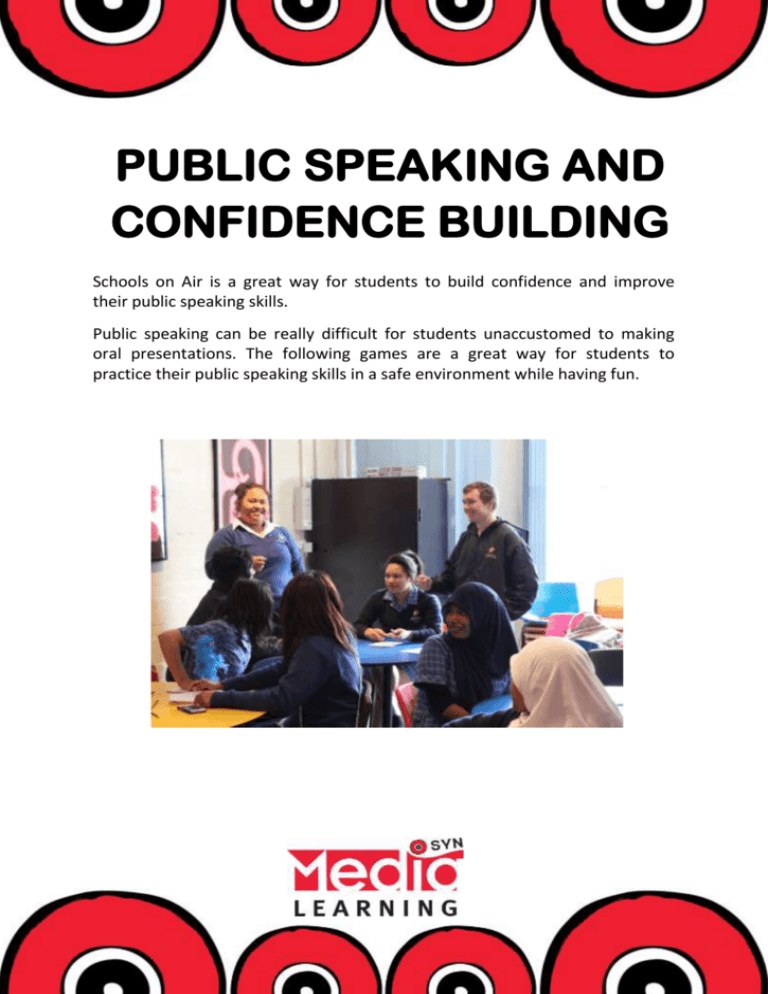
PUBLIC SPEAKING AND CONFIDENCE BUILDING http://www.abc.net.au/btn/story/s3301365.htm Schools on Air is a great way for students to build confidence and improve their public speaking skills. Public speaking can be really difficult for students unaccustomed to making oral presentations. The following games are a great way for students to practice their public speaking skills in a safe environment while having fun. The Um Police Overview This is a combination of two classic public speaking games, in this game students learn to speak clearly when improvising, without having to worrying about content. Number of students required: Ideally groups of three but any size group can work Resources: 100+ words (cut out from sheet provided or make your own) Box, bag or hat for students to draw words out of Clock, stopwatch or phone to time players Method: Put the word cards into box, bag or hat Students decide who is going to be the player, the timer and the um police. The player picks two cards and then must tell a one minute story connecting both words together convincingly. The story needn't be long, complicated or true. Students are not allowed to say “um”, “ah”, “like” or “you know”. The timer times how long the player has been talking for, indicating the half-way point and 10 minutes to go. The um police records how many times the player says “um”, “ah”, “like” or “you know”. Students rotate the roles until everyone has had a go at speaking. The winner is the student who said “um” and “ah” the least amount of times, although there is some competition involved, the atmosphere of the activity should be relaxed and friendly. Once your class is comfortable with connecting two words, add to your word collection and increase the number of cards selected to three or even four or increase the time limit to 2 minutes. elbow watch eyelash skin toe frown foot lettuce paper floor tractor elephant shoe shoulder pyjamas toenail child nose custard slime beard caravan nail garden bridge bottle kidney street bowl boot sock television book mirror bag monkey grandma train chocolate brain pond river jam pillow knee shadow flowers soil daisy radio rockstar tablecloth curtain pizza package cupcake fridge screen mouse leg stomach dancer nurse engine bookcase cave planet rocket star wallet children popcorn dress lipstick bus sandwich rectangle waterfall sand palm tree Take Over Topic Overview This game is similar to the Um Police game but is played by the whole class. This is a great game for preparing students for talking live on radio. Number of students required: Whole class Resources: Topics written on small pieces of paper (can be prepared by students beforehand) Clock, stopwatch or phone to time players Method: Divide your group into two teams and give them a speaking order ie, speaker 1, speaker 2 and so on. Nominate a team to start, speaker 1 takes a topic. The stop watch is started and they begin. The opposing team listens hard for opportunities to take-over the speech. They are when the speaker deviates, hesitates or repeats themself. To take-over, they must call the challenge. Example: The speaker's topic is tennis but he is talking about soccer. The called challenge is deviation. The time keeper stops the watch. The challenger explains the call. The timekeeper judges whether or not it is fair. If it is, the challenger takes over, the stop watch is set again for the remaining time and now the starting speaker's team may challenge. If the challenge is unsuccessful, the original speaker continues. The goal for the speaker is to survive the minute. If they do so, they get ten points. If they don't, whichever team is speaking last gets 5 points. A full game is when you have gone through all the speakers from either side. Expert Speakers Overview The goal of this activity is to improve eye contact, clear speech, and confidence (content isn't important since they are the only "experts" on their subjects!). If you have extra time, they can make a picture or diagram to use as a visual aid. Number of students required: Students can complete this task individually or in pairs. Resources: Paper Pen Coloured Pencils/Textas (if making picture or diagram) Method: Give your students about ten minutes to make up the descriptions of their imaginary animals using the question sheet as a guideline. If time permits students can include a picture or diagram. Students present a short (1-2 minutes) report on their fictional animal. If time permits allow students to take questions from the audience, this will help to give students confidence thinking on their feet without having to worry about giving the wrong answer as any answer they give is the right one because they are the experts! Expert Speakers Use the following questionnaire to create your own fictional animal and present a report on it to your classmates. As you created the animal you are the world’s leading expert on it, this means that you can concentrate on how you speak (pace, clarity, making eye contact) rather than what you are saying. Name of animal What does it look like (size, teeth, fur, scales, nose, claws, color, tail, etc)? Is it a mammal, reptile, amphibian, marsupial? What does it eat? What eats it? What kind of habitat does it live in? Does it make a sound? What survival characteristics does it have (flies, swims, runs, digs, camouflages, fights, etc.) Alvarez, E, Games on Public Speaking Skills for Kids, accessed from www.ehow.com/info_8003542_gamespublic-speaking-skills-kids.html#ixzz2RAgdaEon Dugdale, S, Develop Fluency, Spontaneity and Confidence while having Fun, accessed from http://www.writeout-loud.com/free-word-games.html McIntosh, J, Fun and Quick Public Speaking Activities, accessed from http://resources.prufrock.com/GiftedEducationBlog/tabid/56/articleType/ArticleView/articleId/44/Fun-andQuick-Public-Speaking-Activities.aspx



